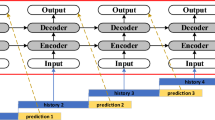Abstract
Host load prediction is significant for improving resource allocation and utilization in cloud computing. Due to the higher variance than that in a grid, accurate prediction remains a challenge in the cloud system. In this paper, we apply a concise yet adaptive and powerful model called long short-term memory to predict the mean load over consecutive future time intervals and actual load multi-step-ahead. Two real-world load traces were used to evaluate the performance. One is the load trace in the Google data center, and the other is that in a traditional distributed system. The experiment results show that our proposed method achieves state-of-the-art performance with higher accuracy in both datasets.










Similar content being viewed by others
References
Akioka S, Muraoka Y (2004) Extended forecast of CPU and network load on computational grid. In: IEEE International Symposium on Cluster Computing and the Grid, 2004. CCGrid 2004. IEEE, pp 765–772
Bengio Y, Simard P, Frasconi P (1994) Learning long-term dependencies with gradient descent is difficult. IEEE Trans Neural Netw 5(2):157–166
Di S, Kondo D, Cirne W (2012) Characterization and comparison of cloud versus grid workloads. In: 2012 IEEE International Conference on Cluster Computing. IEEE, pp 230–238
Di S, Kondo D, Cirne W (2012) Host load prediction in a Google compute cloud with a Bayesian model. In: Proceedings of the International Conference on High Performance Computing, Networking, Storage and Analysis. IEEE Computer Society Press, p 21
Duy TVT, Sato Y, Inoguchi Y (2011) Improving accuracy of host load predictions on computational grids by artificial neural networks. Int J Parallel Emerg Distrib Syst 26(4):275–290
Gers FA, Schmidhuber J (2000) Recurrent nets that time and count. In: Proceedings of the IEEE-INNS-ENNS International Joint Conference on Neural Networks, 2000. IJCNN 2000, vol 3. IEEE, pp 189–194
Gers FA, Schmidhuber J, Cummins F (2000) Learning to forget: continual prediction with lstm. Neural Comput 12(10):2451–2471
Goodfellow I, Bengio Y, Courville A (2016) Deep learning. 2015
Guenter B, Jain N, Williams C (2011) Managing cost, performance, and reliability tradeoffs for energy-aware server provisioning. In: INFOCOM, 2011 Proceedings IEEE. IEEE, pp 1332–1340
Hochreiter S (1991) Untersuchungen zu dynamischen neuronalen netzen. Diploma, Technische Universität München, p 91
Hochreiter S, Schmidhuber J (1997) Long short-term memory. Neural Comput 9(8):1735–1780
Jaeger H, Lukoševičius M, Popovici D, Siewert U (2007) Optimization and applications of echo state networks with leaky-integrator neurons. Neural Netw 20(3):335–352
Krizhevsky A, Sutskever I, Hinton GE (2012) Imagenet classification with deep convolutional neural networks. In: Advances in neural information processing systems, pp 1097–1105
Load traces on unix systems. http://www.cs.cmu.edu/~pdinda/LoadTraces/ (1997)
Lukoševičius M (2012) A practical guide to applying echo state networks. In: Neural networks: tricks of the trade. Springer, pp 659–686
Mell P, Grance T (2011) The NIST definition of cloud computing
Mozer MC (1992) Induction of multiscale temporal structure. In: Advances in neural information processing systems, pp 275–282
Pascanu R, Mikolov T, Bengio Y (2013) On the difficulty of training recurrent neural networks. ICML 3(28):1310–1318
Sutskever I (2013) Training recurrent neural networks. Ph.D. thesis, University of Toronto
The auvergrid traces. http://gwa.ewi.tudelft.nl/datasets/gwa-t-4-auvergrid
Werbos PJ (1990) Backpropagation through time: what it does and how to do it. Proc IEEE 78(10):1550–1560
Wilkes J (2011) More google cluster data. Google research blog, Nov
Williams RJ, Peng J (1990) An efficient gradient-based algorithm for on-line training of recurrent network trajectories. Neural Comput 2(4):490–501
Wu Y, Yuan Y, Yang G, Zheng W (2007) Load prediction using hybrid model for computational grid. In: 2007 8th IEEE/ACM International Conference on Grid Computing. IEEE, pp 235–242
Yang Q, Peng C, Zhao H, Yu Y, Zhou Y, Wang Z, Du S (2014) A new method based on PSR and EA-GMDH for host load prediction in cloud computing system. J Supercomput 68(3):1402–1417
Yang Q, Zhou Y, Yu Y, Yuan J, Xing X, Du S (2015) Multi-step-ahead host load prediction using autoencoder and echo state networks in cloud computing. J Supercomput 71(8):3037–3053
Zhang Q, Zhani MF, Zhang S, Zhu Q, Boutaba R, Hellerstein JL (2012) Dynamic energy-aware capacity provisioning for cloud computing environments. In: Proceedings of the 9th International Conference on Autonomic Computing. ACM, pp 145–154
Acknowledgements
This work was partially supported by Grant No. BE2015152 from the Natural Science Foundation of Jiangsu Province and Grant Nos. 61100111, 61300157, 61201425, 61271231 from the National Natural Science Foundation of China.
Author information
Authors and Affiliations
Corresponding author
Rights and permissions
About this article
Cite this article
Song, B., Yu, Y., Zhou, Y. et al. Host load prediction with long short-term memory in cloud computing. J Supercomput 74, 6554–6568 (2018). https://doi.org/10.1007/s11227-017-2044-4
Published:
Issue Date:
DOI: https://doi.org/10.1007/s11227-017-2044-4




